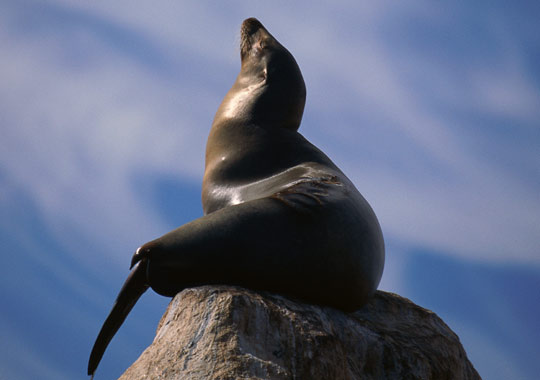
Mapping the California sea lion's (Zalophus californianus) brain with a combination of magnetic resonance imaging (MRI) and volumetric measuring, scientists want to better understand how toxins in the water are causing neurological damage among marine mammal populations.
Eric Montie, a postdoctoral researcher at the University of South Florida, spearheaded the study, which was published in The Anatomical Record in October.
The brain atlas is a first step toward determining whether exposure to manmade chemicals, such as DDT and polychlorinated biphenyls (PCBs), increase California sea lions' susceptibility to life-threatening brain damage from domoic acid, a neurotoxin naturally produced by certain types of algae.
Past studies have concluded that domoic acid, which accumulates in the sea lion's system from ingesting prey that feed on algae, causes the mammal's hippocampus to shrink. Research has also linked domoic acid to acute and chronic epilepsy and seizures in sea lions.
But exactly how that neurotoxin-induced brain damage progresses is still unclear.
"We don't know enough about the endocrinology and neurobiology of these animals," Montie told Discovery News. "That's why you start with baby steps like an atlas."
While similar neurological blueprints exist for primates, MRI technology hadn't been used before to determine the precise volume and layout of brain structures in other species. Montie is especially interested in the size and positioning of the sea lion hippocampus, which plays a fundamental role in spatial memory and navigation.
"We don't know if there's a difference in the size of the hippocampus between (sea lion) males and females, or if there's a difference between young and old animals," Montie says. "We need to get an idea of what a normal hippocampus is supposed to look like throughout its lifetime."
Determining what's "normal" is the first step in tracing abnormal changes in the brain. Domoic acid poisoning occurs in other marine species and sea birds, but Montie says that sea lions seem to be more affected by domoic acid than related pinnipeds, including seals and walruses.
Exposure to manmade chemicals could be the key variable that makes them particularly vulnerable to the neurotoxin.
Sea lions breed around the Channel Islands off the California coast. Dr. John Ramsdell, a supervisory research physiologist who studies algal toxins at the National Oceanic and Atmospheric Administration, says that waters around the islands contain abnormally high levels of DDT and PCBs since nearby factories were once allowed to dump chemical waste directly into the sewage systems.
As a result, California sea lions have absorbed "monstrous levels" of the contaminants, Ramsdell explains. Female sea lions pass along harmful chemicals, especially DDT, to pups in utero and when they nurse.
As studies of human exposure to DDT have also shown, the pesticide likely interferes with normal brain development as the sea lions mature. When they're older, domoic acid then triggers a range of dangerous neurological disorders, including epilepsy.
For Ramsdell and others studying domoic acid toxicity, the sea lion brain atlas will allow them to better track the emergence of epilepsy and other neurological problems from the fetal stage to adulthood, as well as help them diagnose the severity of sea lion brain damage.
"One of the most important things that will come out of this is that there will now be a way to examine the sea lion to see if their pathology indicates if they have a chronic disease or acute poisoning," Ramsdell says. "Just knowing what the anatomy of the sea lion brain looks like is phenomenal."



Reader Comments
to our Newsletter